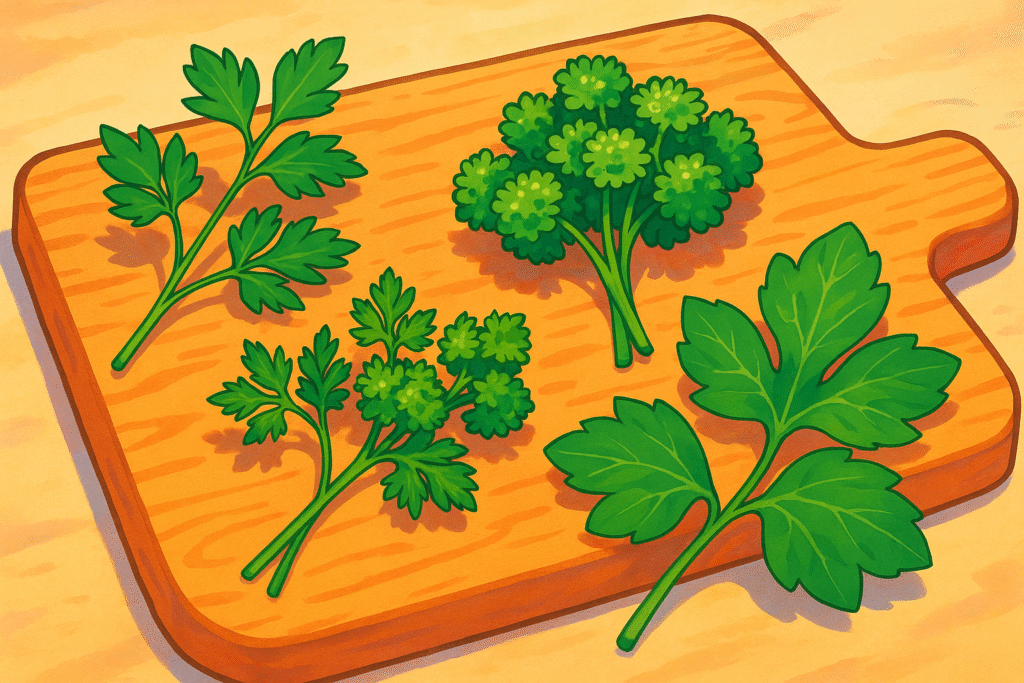Parsley (Petroselinum crispum)

About Parsley
Parsley (Petroselinum crispum) is a vibrant green herb celebrated for its clean, grassy flavor and gentle bitterness. Its tender leaves—curly or flat—brighten salads, soups, tabbouleh, sauces, and garnishes, offering both subtle lift and palate-cleansing freshness. While often seen as a simple garnish, parsley holds a starring role in Middle Eastern, Mediterranean, and European kitchens, from Italian gremolata to Lebanese tabbouleh and French persillade. What sets parsley apart is its versatility: it can stand out or blend in, always adding a gentle herbal layer without overwhelming other flavors.
The History of Parsley
Native to the eastern Mediterranean, parsley has thrived for more than 2,000 years. The ancient Greeks associated it with both celebration and mourning, using it to adorn athletic victors as well as graves. Romans valued parsley as a natural breath freshener and digestive aid, even sprinkling it on banquets. In the Middle Ages, parsley’s use spread across Europe for both culinary and medicinal purposes. Over centuries, parsley became a garden staple from Eastern Europe to North Africa, integrating into national dishes like Argentina’s chimichurri and Turkey’s kisir.
The Science of Parsley
Parsley’s vibrant flavor and aroma come from essential oils like myristicin and apiol, along with a high chlorophyll content. Rich in vitamin K, vitamin C, and folate, parsley is also a notable source of flavonoid antioxidants such as apigenin and luteolin. These compounds are studied for their anti-inflammatory and immune-boosting properties. The plant’s aroma, especially in flat-leaf varieties, is due to volatile oils most concentrated in the stems. Parsley’s light bitterness and clean finish come from its unique balance of phenolic compounds and natural minerals.
The Geography of Parsley
Originally wild along Mediterranean coasts, parsley now grows in gardens and fields worldwide, thriving in mild, well-drained soil. Italy, France, Turkey, and the Middle East remain epicenters for culinary parsley cultivation, each favoring different varieties. Flat-leaf parsley (Italian parsley) grows heartier and more aromatic in the Mediterranean sun, whereas curly-leaf parsley, favored in northern and central Europe, is resilient to cooler climates. In the Levant and North Africa, lush bunches of parsley are harvested all year, often forming the green backbone of salads and wrapped dishes.
Varieties of Parsley
Flat-Leaf Parsley (Italian Parsley)
With broad, deeply cut leaves, this type offers a robust taste and pronounced fragrance. Dominates Mediterranean and Middle Eastern cooking; perfect for sauces, salads, and finishing dishes.
Curly-Leaf Parsley (Common Parsley)
Compact and decorative, curly parsley’s crisp leaves are milder in flavor and widely used for garnishes. Loved in European kitchens for its visual appeal atop soups and roasted dishes.
Hamburg Parsley (Root Parsley)
Common in Central and Eastern Europe, this variety is grown for its thick, edible root, which resembles parsnip. The root is used in soups and stocks, while the greens lend herbal brightness.
FAQs All your questions about Parsley: answered
Is flat-leaf or curly parsley better for cooking?
Flat-leaf (Italian) parsley is generally preferred by chefs for its more intense flavor and ease of chopping, while curly parsley adds a decorative touch and a gentler taste.
Can parsley stems be eaten?
Absolutely. Parsley stems are tender and packed with flavor, perfect for stocks, sauces, and blended herb pastes. Just chop finely since they can be fibrous in large pieces.
Does parsley have health benefits?
Yes—parsley is rich in vitamin K, vitamin C, and antioxidants. It’s also traditionally valued for digestive, anti-inflammatory, and even diuretic effects.
How should parsley be stored?
Keep bunches in the fridge, stems in water (like cut flowers) covered loosely, or wrapped in damp paper towel and stored in a plastic bag. For long-term storage, parsley can be chopped and frozen.
Does parsley taste the same around the world?
Climate, soil, and type make a difference. Mediterranean parsley tends to be more fragrant and flavorful, while varieties grown in cooler climates may be milder or even slightly peppery.